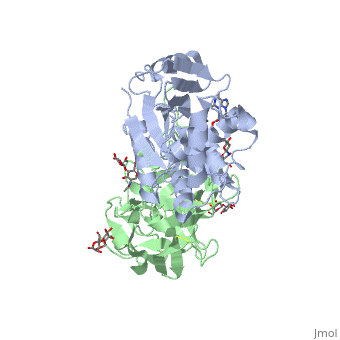Ricin: Structure and function
From Proteopedia
(Difference between revisions)
| Line 17: | Line 17: | ||
== Mechanism of Action == | == Mechanism of Action == | ||
When the A chain and B chain are joined, they are able to work together to carry out enzymatic activity within an organism. Because they have two completely different properties, their individual functions work together. The main goal of ricin is to inhibit protein synthesis, a process that heavily relies on organelles called ribosomes. When these ribosomes are damaged or inactivated, this halts protein synthesis within a cell. | When the A chain and B chain are joined, they are able to work together to carry out enzymatic activity within an organism. Because they have two completely different properties, their individual functions work together. The main goal of ricin is to inhibit protein synthesis, a process that heavily relies on organelles called ribosomes. When these ribosomes are damaged or inactivated, this halts protein synthesis within a cell. | ||
| - | At the start of the process, the B chain’s purpose is to gain entry into a target cell so that the A chain can carry out ribosomal deactivation. As Ricin B attaches to the galactose residues on a cell membrane, the protein is able to invade the cell through the cleavage of the cell membrane, endocytosis. Now that the B chain has done its part in the protein’s function, Chain A has entry into the cytosol of the cell<ref>PMID: 8119491 | + | At the start of the process, the B chain’s purpose is to gain entry into a target cell so that the A chain can carry out ribosomal deactivation. As Ricin B attaches to the galactose residues on a cell membrane, the protein is able to invade the cell through the cleavage of the cell membrane, endocytosis. Now that the B chain has done its part in the protein’s function, Chain A has entry into the cytosol of the cell<ref>PMID: 8119491</ref>. |
| - | After Ricin enters the cell, the disulfide bond between the A and B chains is cleaved and the A chain is released into the cell, working its way to the Golgi network. Ricin A functions to deactivate ribosomal activity through elongation. The enzymatic activity of this protein can inactivate thousands of ribosomes per minute, making it a very fast acting protein. As stated in the structure of the protein, there is a ricin loop on chain A where two tyrosine residues play an important role in the deactivation of the ribosome. <scene name='91/910715/Tyr80_123/1'>Tyr80 and Tyr123</scene> sandwich an adenine to inhibit further protein synthesis. After protein production in a cell is stopped, it is unclear whether the two chains link back together and move on to another cell or whether other cells are affected by new ricin proteins<ref>PMID: 8119491 | + | After Ricin enters the cell, the disulfide bond between the A and B chains is cleaved and the A chain is released into the cell, working its way to the Golgi network. Ricin A functions to deactivate ribosomal activity through elongation. The enzymatic activity of this protein can inactivate thousands of ribosomes per minute, making it a very fast acting protein. As stated in the structure of the protein, there is a ricin loop on chain A where two tyrosine residues play an important role in the deactivation of the ribosome. <scene name='91/910715/Tyr80_123/1'>Tyr80 and Tyr123</scene> sandwich an adenine to inhibit further protein synthesis. After protein production in a cell is stopped, it is unclear whether the two chains link back together and move on to another cell or whether other cells are affected by new ricin proteins<ref>PMID: 8119491</ref>. |
== Ricin Poisoning: Symptoms == | == Ricin Poisoning: Symptoms == | ||
Now that we understand the structure and mechanism of action behind Ricin, how can we make sure we take the correct steps in identifying if you may have been exposed to this protein? The main mechanism of this protein is its ability to halt protein synthesis. Because it doesn’t damage the cell directly and instead stops it’s functioning, the symptoms of ricin poisoning can take up to a couple days to be noticed, depending on exposure and dose. | Now that we understand the structure and mechanism of action behind Ricin, how can we make sure we take the correct steps in identifying if you may have been exposed to this protein? The main mechanism of this protein is its ability to halt protein synthesis. Because it doesn’t damage the cell directly and instead stops it’s functioning, the symptoms of ricin poisoning can take up to a couple days to be noticed, depending on exposure and dose. | ||
Revision as of 21:47, 29 April 2022
| |||||||||||
References
- ↑ Etimad, L., Moshiri, M., & Hamid, F. (2019, June 6). Ricin: An ancient story for a timeless plant toxin. RBMB. Retrieved April 23, 2022,
- ↑ Tumer, N. E. (2019). Introduction to the Toxins Special Issue “Ricin Toxins.” Toxins, 12(1).
- ↑ Lord JM, Roberts LM, Robertus JD. Ricin: structure, mode of action, and some current applications. FASEB J. 1994 Feb;8(2):201-8. PMID: 8119491.
- ↑ Audi J, Belson M, Patel M, Schier J, Osterloh J. Ricin Poisoning: A Comprehensive Review. JAMA. 2005;294(18):2342–2351. doi:10.1001/jama.294.18.2342
- ↑ Lord JM, Roberts LM, Robertus JD. Ricin: structure, mode of action, and some current applications. FASEB J. 1994 Feb;8(2):201-8. PMID:8119491
- ↑ Lord JM, Roberts LM, Robertus JD. Ricin: structure, mode of action, and some current applications. FASEB J. 1994 Feb;8(2):201-8. PMID:8119491
- ↑ Gal, Y., Mazor, O., Falach, R., Sapoznikov, A., Kronman, C., & Sabo, T. (2017). Treatments for Pulmonary Ricin Intoxication: Current Aspects and Future Prospects. Toxins, 9(10).

